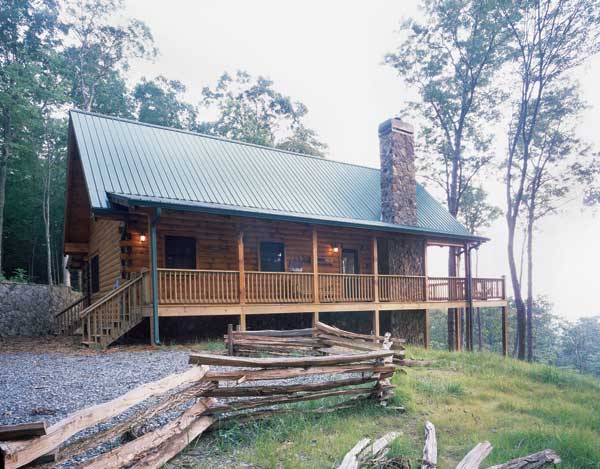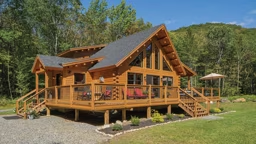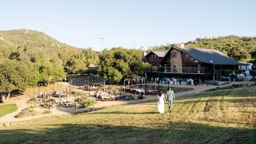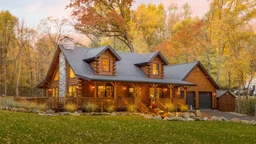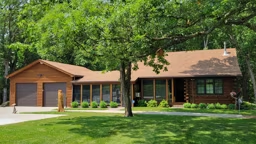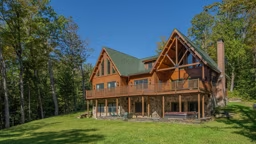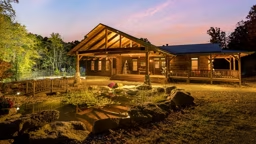Jim and Maraul Boulware own and operate a thriving accounting firm in Atlanta and wanted to build a log home in the mountains as a downtime getaway. They didn’t want a palace-sized structure — they wanted beauty and efficiency in a small log home.
They were willing to be patient and thorough in building just the right home and finding a log home company with whom they could work. Friends had advised the Boulwares that Fireside Log Homes had a great reputation for their log treatment process as well as for building fine homes, so Jim and Maraul went directly to that Ellijay, Georgia, company.
 In keeping with the small size of this room, decor has been wisely left simple. The couple has used earth tones and animal themes for accent — nothing too bold or strident.
In keeping with the small size of this room, decor has been wisely left simple. The couple has used earth tones and animal themes for accent — nothing too bold or strident.
The Boulwares were willing to invest a great deal of time working with the staff at Fireside for their small cabin. The plan they selected was around 1,500 square feet and affords all the space they needed. The success of this house was all about planning.
“Not only did we meet with Fireside’s architect and our builder, we met with the person drawing the cabin plans many times, refining an already established Fireside design,” Jim says.
This process took a couple of months, but Jim and Maraul knew what they wanted and were aware of how important it is to make needed changes and alterations in the plans while they are being drawn instead of during construction.
The Log Home Interior
They had two lists of must-haves for the house. In the “lifestyle” column was an open floor plan with a spacious great room, a loft with covered deck space on three sides of the house, and lots of glass so that they could enjoy their mountain views from almost anywhere in the house.
They also had a more technical list. The house would have to include well-fitting logs to prevent heat loss, bug damage (like that from carpenter bees) and shrinkage. These logs had to be treated to prevent all of these possibilities. Jim and Maraul got what they wanted. From the technical aspect, the home exceeded expectations.
“We had owned and sold another log home about the size of this one,” Jim says. “Each year we used 800 to 1,000 gallons of propane gas. In this house, we use only about 400 — that’s how tight this house is. And after two years, we have seen no shrinkage and no evidence of any bug damage.”
From a lifestyle perspective, their wish list was also answered. Although the footprint of the great room is relatively small, the living room portion of the space is two- story; this gives the room a bright and airy ambiance.
The Boulwares also kept the television and other electronic entertainment upstairs in a loft family room, maintaining the downstairs living room as an uncluttered place for conversation and visiting. Jim and Maraul feel that even though they spent more money than called for by the original plan (they slightly altered an existing Fireside plan), they managed to keep the house small and still get a lot of bang for their log buck.
 Who needs a swimming pool when you can have a hot tub (or cool tub in the summer) right outside of the deck from your bedroom?
Who needs a swimming pool when you can have a hot tub (or cool tub in the summer) right outside of the deck from your bedroom?
Changes they made to the plan included:
- Covering the decks that were in the original plans to changes them into porches. This gives them a great deal more outdoor living space for at least three seasons a year.
- Expanding the porches to 10 feet deep instead of the more building-traditional eight feet that appeared the original plan. The Boulwares get more breathing room and the house appears larger.
One key aspect to building a small and energy-efficient log home, the Boulwares say, is to find the right builder.
“Your builder is almost totally responsible for the success of any log home,” Jim says.
They cite their builder, Rusty Rhodes, as a thorough professional. Jim and Maraul Boulware’s small mountain log retreat is proof that you don’t have to build large to build smart and that great log lifestyle can come in a smaller package.




